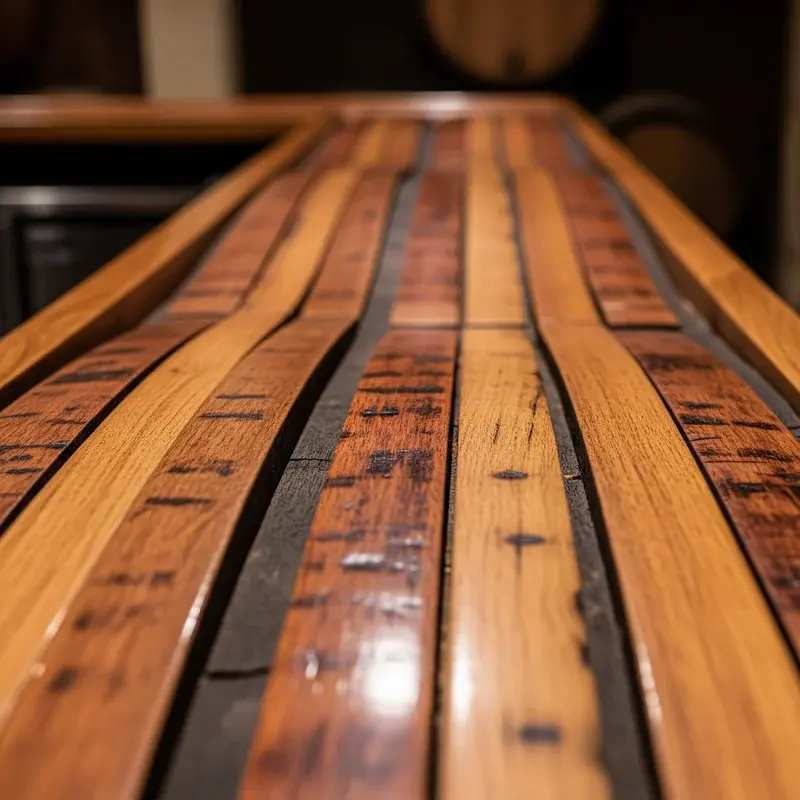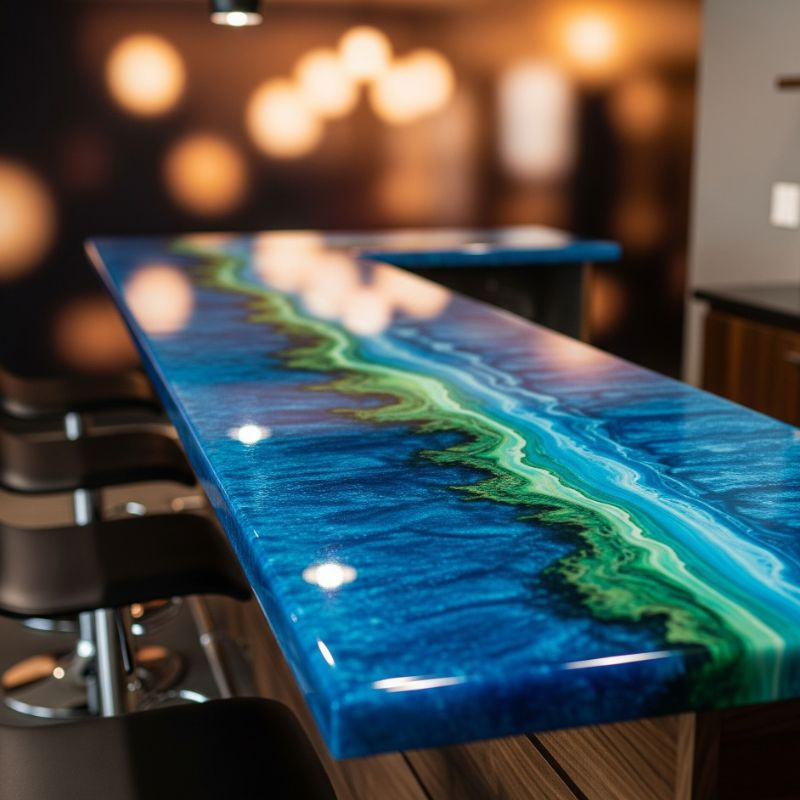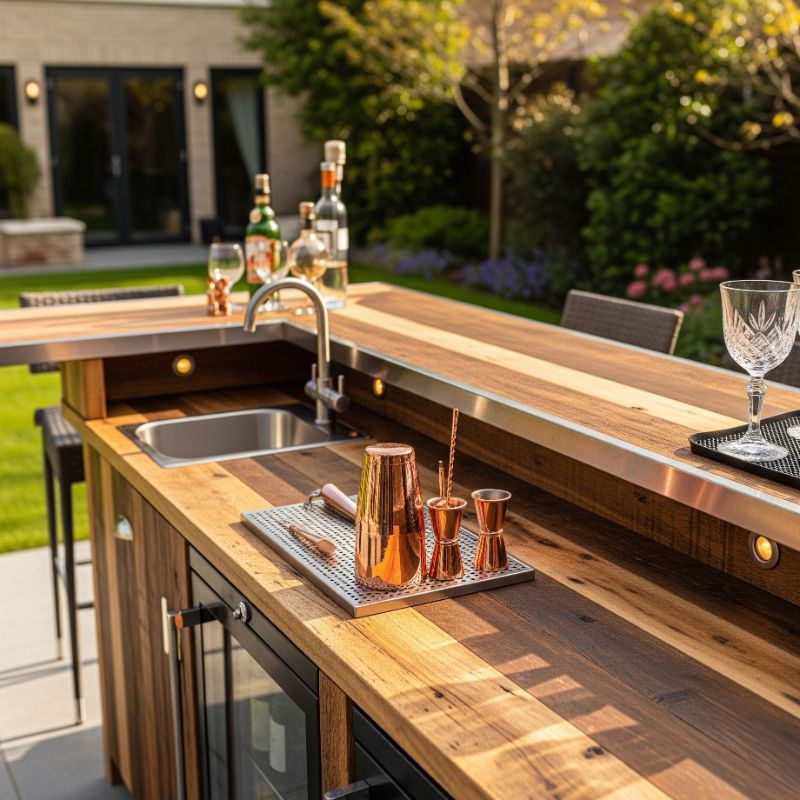15 Wood Bar Top Ideas for a Warm and Rustic Look
- Sophia Mitchell

- Oct 23
- 9 min read
Transform your bar with these 15 gorgeous wood bar top ideas. From live edge to reclaimed barn wood, create the perfect rustic focal point!

Picture this: you're running your hand across a beautifully weathered wood bar top, feeling every grain, every story etched into its surface. That's the magic of wood in bar design. It's not just a surface; it's the heart of your entertainment space, where drinks are poured, stories are shared, and memories take root. Whether you're designing a home bar, renovating a commercial space, or dreaming about that perfect kitchen island bar, the right wood top transforms ordinary into extraordinary. Wood brings warmth that stone can't match and character that laminate can only imitate. From the raw beauty of live edges to the refined elegance of butcher block, these 15 wood bar top ideas will inspire you to create a space that beckons people to pull up a stool and stay awhile.
1. Live Edge Walnut Bar Tops
There's something absolutely mesmerizing about live edge walnut that stops people in their tracks. The natural, unfinished edge preserves the tree's original shape, creating an organic flow that manufactured edges simply can't replicate. Black walnut especially offers rich chocolate tones with stunning grain patterns that deepen with age. When you install a live edge bar top, you're essentially bringing a piece of forest history into your space. The irregular edge becomes a conversation starter, while the smooth finished surface provides perfect functionality. Select slabs with interesting features like small knots or subtle cracks filled with epoxy for added character. The contrast between refined and raw makes every drink feel like it's served at nature's own table.

2. Reclaimed Barn Wood Surfaces
Old barn wood carries stories in every nail hole, saw mark, and weathered groove, making it perfect for creating authentic rustic bar tops. This sustainable choice transforms wood that might otherwise be discarded into the centerpiece of your entertainment space. The natural aging process creates colors and textures that would take decades to replicate artificially. Mix boards of varying widths and tones for a patchwork effect that looks naturally accumulated over generations. The slightly uneven surface adds tactile interest, though proper sealing ensures it's smooth enough for glass placement. Each piece might come from different parts of a barn, combining floor planks, wall boards, and beam cuts into one harmonious surface that celebrates American agricultural heritage.

3. Butcher Block Maple Counters
Butcher block brings professional kitchen durability to your bar while maintaining that warm, inviting wood aesthetic we're after. Hard maple's tight grain resists moisture and bacteria, making it ideal for bars where spills are inevitable. The classic strip pattern creates visual rhythm that guides the eye along the bar's length. These tops develop a gorgeous patina with use, actually improving in character over time rather than deteriorating. The blonde tones of maple brighten spaces and pair beautifully with both dark and light cabinetry. Regular oiling keeps the surface food-safe and brings out the wood's natural luster. Unlike stone or metal, butcher block stays comfortable to lean on during long conversations, never feeling cold or harsh against your arms.

4. Epoxy River Table Designs
Imagine a crystal-clear river running through the center of your bar top, separating two pieces of stunning wood like nature's own artwork. Epoxy river tables combine natural wood with modern resin techniques to create showstopping surfaces that blur the line between functional furniture and art installation. Choose colored epoxy to match your decor, or keep it clear to showcase embedded elements like stones, shells, or LED lights. The smooth epoxy center provides an incredibly durable surface for high-traffic bar areas while the wood edges maintain that organic warmth. These designs work especially well with live edge pieces, where the resin appears to flow naturally between the wood's curves. Every river table is completely unique, ensuring your bar has a one-of-a-kind centerpiece.

5. Distressed Pine Plank Tops
Pine might be considered common, but distressed properly, it transforms into rustic gold that rivals any expensive hardwood. The soft nature of pine actually works to your advantage here, allowing for authentic distressing techniques that create instant age. Beat it with chains, sand it unevenly, or use vinegar and steel wool solutions to achieve that perfectly imperfect weathered look. Wide planks showcase the wood's pronounced grain patterns and occasional knots that add character. The light color of pine makes spaces feel larger and more open, perfect for smaller bar areas. Layer different stain colors and sand through them to create depth that mimics decades of use. This affordable option proves you don't need exotic woods to achieve stunning rustic results.

6. Exotic Hardwood Selections
Take your bar global with exotic hardwoods like zebrawood, purpleheart, or teak that bring unique colors and patterns impossible to find in domestic species. These conversation-starting woods transform your bar into a showcase of natural artistry. Zebrawood's dramatic striping creates built-in visual interest, while purpleheart's unusual purple hue deepens to rich brown-purple over time. Teak's natural oils make it virtually maintenance-free and perfect for outdoor bars. The density of exotic hardwoods means they'll outlast multiple generations with proper care. Yes, they cost more initially, but consider it an investment in a surface that becomes more valuable with age. Mix exotic wood accents with domestic woods if full exotic tops exceed your budget; even small sections create impressive focal points.

7. Burnt Wood Shou Sugi Ban Technique
This ancient Japanese preservation technique creates the most dramatic black finish while actually protecting the wood underneath. By carefully charring the surface then brushing and oiling, you achieve a deeply textured, almost alligator-skin appearance that's absolutely unique. The charring process makes the wood naturally resistant to rot, insects, and fire, perfect for bars that see heavy use. The deep black provides stunning contrast against light walls or cabinetry, creating a bold modern-meets-rustic statement. Different wood species char differently; cedar creates the most traditional appearance, while oak produces deeper texture. The burnt surface feels surprisingly smooth after proper finishing, and the preserved wood grain still shows through the char, creating subtle dimensionality in different lighting.

8. Mixed Wood Patchwork Designs
Why choose one wood when you can celebrate them all? Patchwork bar tops combine different wood species, colors, and grain patterns into a mosaic that's both artistic and functional. Think of it as a wooden quilt that tells multiple stories simultaneously. Arrange pieces randomly for an eclectic look, or create patterns with alternating light and dark woods. This technique works brilliantly for using up smaller pieces of premium wood that might otherwise go to waste. The varying heights and textures of different woods can be planed smooth or left slightly irregular for added tactile interest. Each section ages differently, creating an evolving patina that becomes more complex over time. This approach lets you incorporate sentimental wood pieces, like grandpa's old workbench or wood from a childhood home.

9. Thick Slab Oak Installations
Nothing says substantial quite like a three-inch-thick oak slab stretching the length of your bar. These massive pieces make a statement about permanence and quality that thin veneered tops can't match. White oak's pronounced cathedral grain patterns create natural artwork, while red oak offers warmer tones with tighter grain. The thickness allows for substantial edge profiles, from simple rounded edges to elaborate carved details. These slabs can span impressive lengths without support, creating clean lines uninterrupted by seams. The weight and density of thick oak means it stays put and doesn't transmit vibrations, keeping drinks stable even during enthusiastic bar-side conversations. Over time, oak develops a rich amber patina that only improves its appearance.

10. Driftwood and Beach Wood Creations
Bring coastal vibes inland with bar tops crafted from driftwood and beach-weathered timber that nature has already perfectly distressed. These pieces carry the romance of ocean adventures and beachcombing discoveries. The salt and sun bleaching creates silver-gray tones impossible to replicate with stains, while the smooth, worn texture feels like silk under your hands. Arrange pieces in their natural irregular shapes for an organic mosaic, or cut them into more uniform planks while preserving their weathered faces. The natural holes and grooves can be filled with colored epoxy to suggest tide pools. This sustainable option gives new life to wood that's already completed its first purpose. Each piece's journey from forest to sea to your bar makes for fascinating conversation.

11. Wine Barrel Stave Surfaces
Transform wine or whiskey barrel staves into a bar top that literally carries the essence of aged spirits in its wood. The curved staves create subtle undulation across the surface, adding visual and tactile interest. The interior faces show beautiful staining from years of wine or whiskey contact, creating natural color variation that can't be faked. Arrange staves side by side for a traditional look, or alternate directions for a chevron pattern. The oak used in barrel construction is specially selected for density and grain tightness, making these tops incredibly durable. The char marks from whiskey barrels add black accents that complement any color scheme. Some staves still carry cooperage stamps and markings that add authentic detail to your design.

12. Bookmatched Wood Grain Patterns
Bookmatching creates perfect symmetry by opening sequential wood slices like pages in a book, revealing mirror-image grain patterns that look like nature's Rorschach test. This technique works especially well with woods featuring dramatic grain or figure, like flame maple or burled walnut. The centerline where pieces meet becomes a focal point that draws the eye and creates natural bar sections. Large bookmatched panels make smaller bars appear grander, while the symmetry brings order to busy spaces. The matching process requires careful selection and alignment, making each bookmatched top a testament to craftsmanship. When lit from the side, the mirrored grain creates subtle light play that changes throughout the day. This sophisticated technique elevates rustic wood into the realm of fine furniture.

13. Rustic Cedar Log Tops
Half-log cedar tops maintain the tree's natural round profile on the bottom while providing a flat surface on top, creating the ultimate rustic statement. The aromatic oils in cedar provide natural insect resistance and a pleasant scent that enhances the bar experience. Leave the bark on for maximum rustic appeal, or remove it to showcase the stunning contrast between heartwood and sapwood. Cedar's natural weather resistance makes it perfect for outdoor bars or humid environments. The irregular live edges follow the tree's natural growth patterns, ensuring no two installations look identical. These substantial pieces work especially well in cabin or lodge settings where they complement log construction. The soft wood is easy to customize with carved details or branded designs.

14. Herringbone Pattern Wood Surfaces
Herringbone patterns bring sophisticated geometry to rustic wood, creating visual movement that makes bar tops feel dynamic and engaging. This classic pattern works with any wood species but looks particularly striking with contrasting wood tones. The angled pieces create natural sight lines that can make narrow bars appear wider or guide flow in larger spaces. Installation requires precision, but the result is a surface that looks far more expensive than its material cost. The pattern naturally hides seams and joints, making it perfect for piecing together shorter wood sections into longer runs. Each piece catches light differently due to grain direction, creating subtle shimmer effects. This timeless pattern bridges traditional and contemporary styles, making your bar feel both classic and current.

15. Two-Tone Wood Combinations
Combining light and dark woods in deliberate patterns creates visual interest that prevents large bar tops from feeling monotonous. Picture mahogany borders framing maple centers, or walnut and ash in alternating stripes. These combinations let you incorporate expensive woods as accents without breaking the budget on solid exotic tops. The contrast helps define different bar zones, like separating prep areas from serving surfaces. Use the wood tones to echo other room elements, tying your bar into the overall design scheme. The junction between different woods becomes a design feature when emphasized with thin metal strips or contrasting wood inlays. This technique also allows you to combine woods with different properties, using harder woods in high-wear areas and decorative species where they'll be appreciated.

Conclusion
Your bar top isn't just a surface; it's the stage where life's best moments unfold. These 15 wood ideas prove that rustic doesn't mean rough, and warmth doesn't sacrifice sophistication. Whether you choose the raw beauty of live edge or the refined elegance of bookmatched patterns, wood brings soul to your space that no other material can match. Start planning your perfect bar top today, and create a gathering place that'll serve memories for generations.
FAQs
Q1: How thick should a wood bar top be for stability?
A: Minimum 1.5 inches thick, though 2-3 inches provides better stability and appearance.
Q2: What's the best finish for protecting wood bar tops?
A: Marine-grade polyurethane or bar top epoxy provides maximum durability against spills.
Q3: Can I install a wood bar top over existing counters?
A: Yes, secure properly with construction adhesive and brackets for permanent installation.
Q4: How often should I oil my wood bar top?
A: Oil every 3-6 months depending on use and wood type.
Q5: What wood species resists water damage best?
A: Teak, white oak, and cedar naturally resist moisture better than others.



Comments